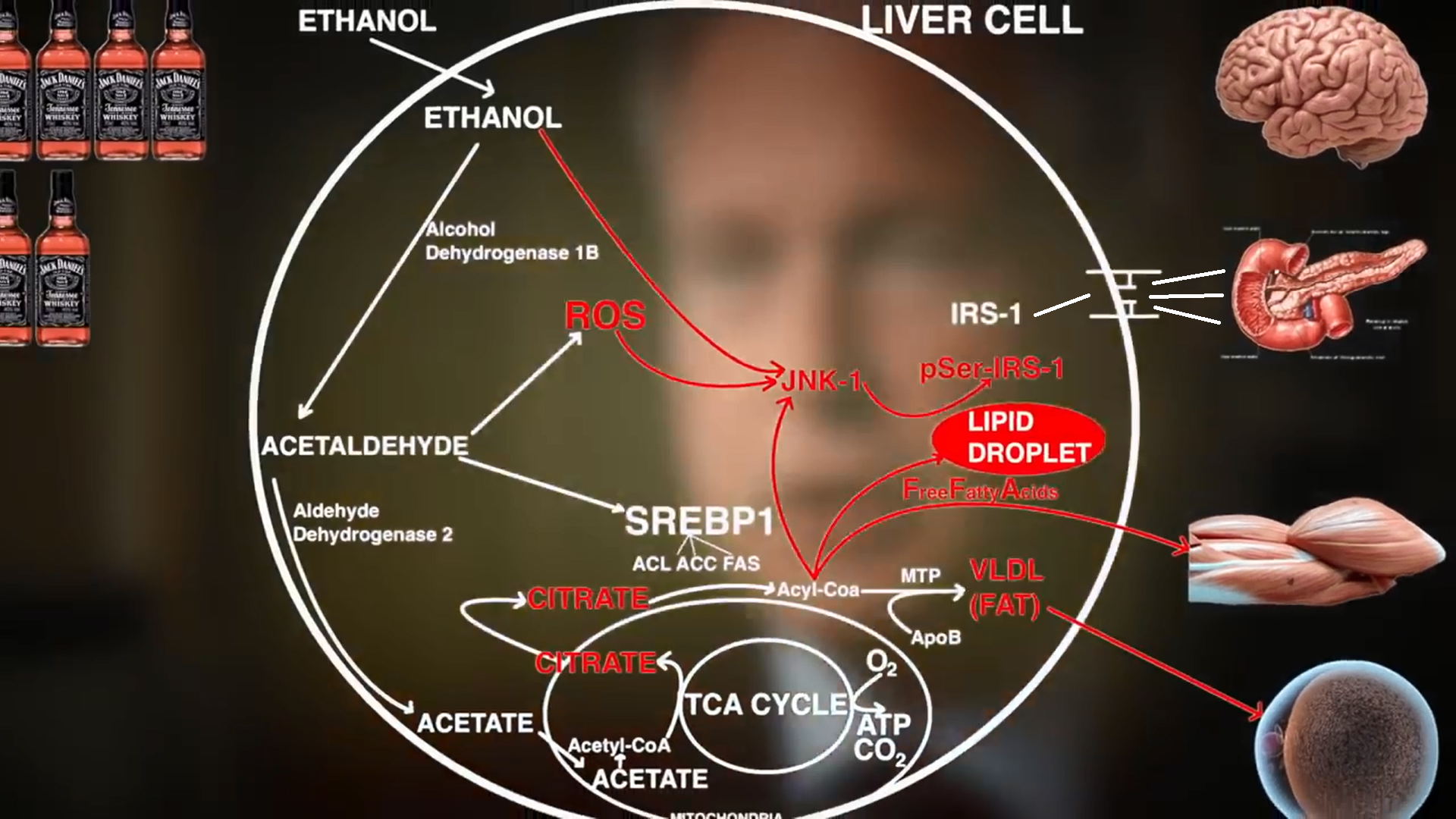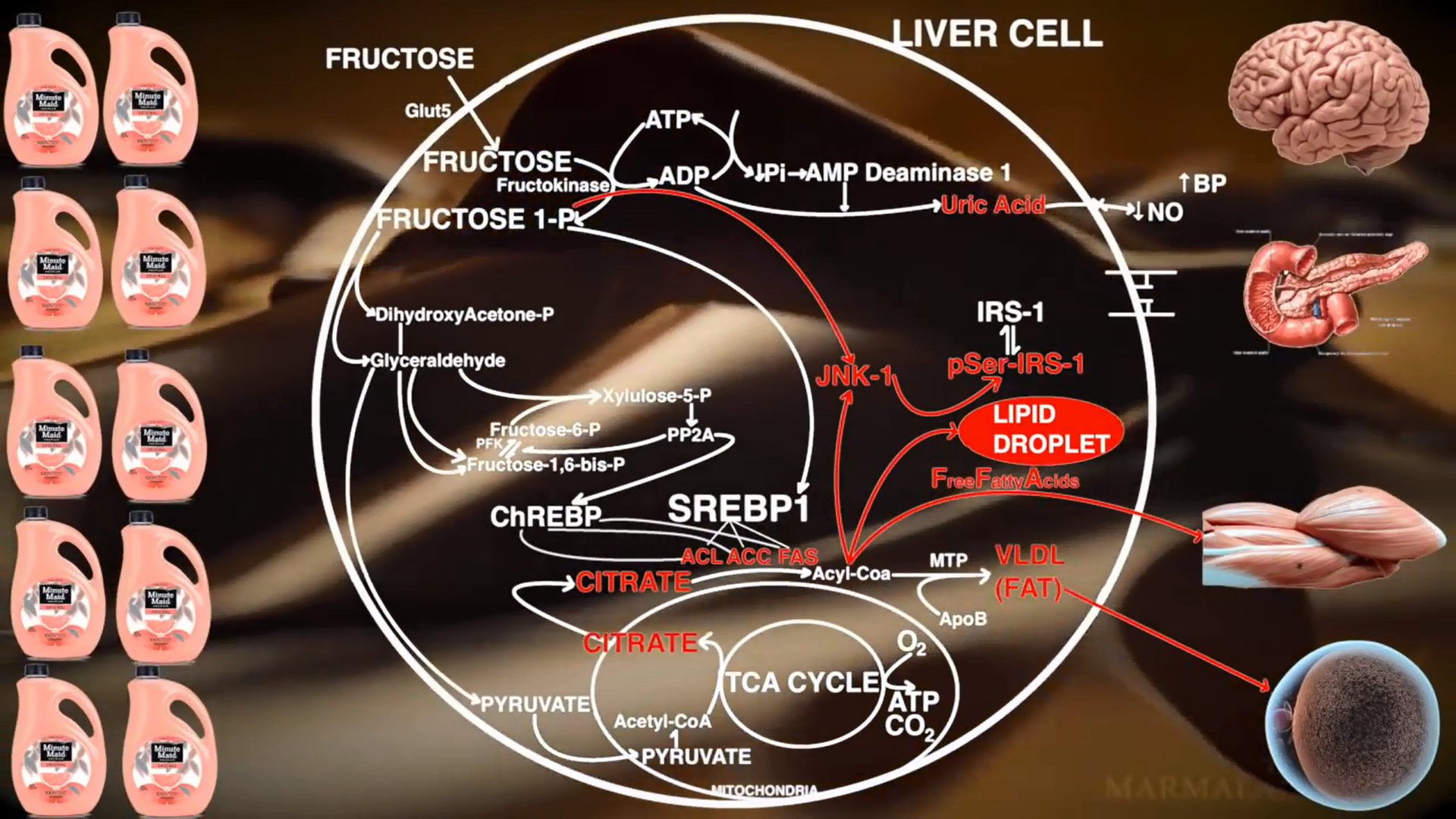- Joined
- Mar 18, 2012
- Messages
- 2,759
Alcohol and Sugar Metabolism, and why a calorie is not always a calorie.
Currently a work in progress so please bear with me..
A brief intro on alcohol action and harm:
10% is metabolised by the brain which is responsible for irregular HR, blood vessel dilation, loss of fine motor control, alcohol is a toxin.
80% of alcohol is metabolised by the liver, therefore an individual can develop serious liver issues relatively quickly if drinking on a daily basis.
Acute Exposure:
CNS depression
Blood vessel dilation
Hypothermia
Tachycardia
Myocardial depression
Slowed pupil response
Diuresis
Hypoglycemia
Motor control loss
Chronic Exposure:
Blood disorders
Electrolyte abnormalities
Hypertension
Cardiac dilation
Heart disease
High blood triglycerides
Pancreatitis
Malnutrition
Obesity
Fatty liver disease
Fetal alcohol syndrome
Addiction
Glucose/Starch Metabolism:
When ingesting carbohydrate sources such as bread/potatoes, only 20% will eventually get metabolised by the liver, the other 80% is metabolised by other cells in the body.
Before glucose can enter cell it must stimulate pancreas to release insulin. Insulin stimulates IRS-1 which in turn activates SREBP-1, which triggers action of enzyme glucokinase which transforms glucose to glucose 6-Phosphate, which mostly gets stored in the liver as glycogen.
Glycogen acts as a reserve of energy that the body can access as necessary, that is why runners carb load before a race.
What doesn?€™t make it as glycogen gets metabolised down to pyruvate which enters mitochondria and converts pyruvate to Acetyl-CoA, which is used in The Citric Acid cycle to produce adenosine triphosphate (ATP). Not all gets burned of so some is left as citrate which in turn activates SREBP-1 and starts De novo lipogenesis (novo = new, lipo = fat, genesis = making), cells take leftover citrate and convert into fat.
The liver packages fat into VLDL, which transports and distributes to fat cells (adipose tissue) or other cellular energy requirements.
Only 20% of glucose made it to the liver, then half went to glycogen, most was burned off for energy, only about 1/50th of what you eat will be packaged into VLDL.
Ethanol:
Ethanol is not needed for any biochemical process, so most is treated as a toxin in the liver. 10% will get processed in the stomach/intestines, another 10% by kidneys, muscle and brain. The liver has to work 4X as hard to process 80% of alcohol that is ingested.
Ethanol doesn?€™t need insulin to enter cell, it diffuses into cell and converts to Acetaldehyde which generates R.O.S. that damage proteins within the body, cause cancer, and are key to aging.
Acetaldehyde converts to acetate and enters mitochondria, this overloads mitochondria, leaving large amounts of citrate, which synthesises a large volume of fat as packaged VLDL which is transported and deposited mainly as visceral fat. This causes several health issues and surrounds organs giving a big gut appearance.
The liver ends up with high levels of fat that it doesn?€™t want so exports out as free fatty acids, which enter muscle and cause muscle insulin resistance. (via downregulating GLUT4)..
Some fat is unable to exit liver so ends up as fat droplets sitting in the liver alcoholic fatty liver disease.
Excess Acetyl-CoA, ethanol, and R.O.S activate enzyme JNK-1 which is a bridge between metabolism and inflammation, this further damages the liver, and promotes insulin resistance, within the liver by inactivating IRS-1, making the pancreas work harder via producing more insulin.
Sugar:
Table sugar, (sucrose) is made up of one molecule glucose, and one molecule fructose, found in honey, fruit juice, high fructose corn syrup, coke, etc.
Fructose is not necessary to the body, so is treated like a foreign substance, 100% is processed by the liver, metabolized to pyruvate, enters mitochondria, doesn?€™t get stored as glycogen. TCA cycle produces large volumes of citrate which is packaged into VLDL and responsible for visceral fat accumulation soda belly. This exits cells as free fatty acids leading to insulin resistance in muscle. Not all fat can get out of cell so fat accumulates in liver, non - alcoholic - fatty - liver - disease. JNK-1 stimulation promotes inflammation, JNK-1 acts on IRS-1 receptor causing insulin resistance within the liver.
On the same caloric intake, introducing high fructose foods can increase visceral fat and increase body weight, and insulin resistance, and induce non alcoholic fatty liver disease.
Fructose metabolism generates fat via Xylulose 5-Phosphate which further stimulates de novo lipogenesis enzymes which increase fat synthesis. Also conversion to fructose 1-Phosphate produces uric acid which further raises BP causing hypertension.
So, A Calorie is not a Calorie, depending on where it comes from.
Fibre helps prevent fructose in fruit becoming a problem by reducing the rate of intestinal absorption, ie: the liver can easily handle the steady stream of sugar from fruit, the fibre will also fill you up..
Sugar:
Increase likelihood of alzheimer's
Increase acne
Increase depression
Reduce sleep
Increase chances of diabetes
Increase cancer risk
Reduced eyesight
Increase weight
Reduce immune function



Currently a work in progress so please bear with me..
A brief intro on alcohol action and harm:
10% is metabolised by the brain which is responsible for irregular HR, blood vessel dilation, loss of fine motor control, alcohol is a toxin.
80% of alcohol is metabolised by the liver, therefore an individual can develop serious liver issues relatively quickly if drinking on a daily basis.
Acute Exposure:
CNS depression
Blood vessel dilation
Hypothermia
Tachycardia
Myocardial depression
Slowed pupil response
Diuresis
Hypoglycemia
Motor control loss
Chronic Exposure:
Blood disorders
Electrolyte abnormalities
Hypertension
Cardiac dilation
Heart disease
High blood triglycerides
Pancreatitis
Malnutrition
Obesity
Fatty liver disease
Fetal alcohol syndrome
Addiction
Glucose/Starch Metabolism:
When ingesting carbohydrate sources such as bread/potatoes, only 20% will eventually get metabolised by the liver, the other 80% is metabolised by other cells in the body.
Before glucose can enter cell it must stimulate pancreas to release insulin. Insulin stimulates IRS-1 which in turn activates SREBP-1, which triggers action of enzyme glucokinase which transforms glucose to glucose 6-Phosphate, which mostly gets stored in the liver as glycogen.
Glycogen acts as a reserve of energy that the body can access as necessary, that is why runners carb load before a race.
What doesn?€™t make it as glycogen gets metabolised down to pyruvate which enters mitochondria and converts pyruvate to Acetyl-CoA, which is used in The Citric Acid cycle to produce adenosine triphosphate (ATP). Not all gets burned of so some is left as citrate which in turn activates SREBP-1 and starts De novo lipogenesis (novo = new, lipo = fat, genesis = making), cells take leftover citrate and convert into fat.
The liver packages fat into VLDL, which transports and distributes to fat cells (adipose tissue) or other cellular energy requirements.
Only 20% of glucose made it to the liver, then half went to glycogen, most was burned off for energy, only about 1/50th of what you eat will be packaged into VLDL.
Ethanol:
Ethanol is not needed for any biochemical process, so most is treated as a toxin in the liver. 10% will get processed in the stomach/intestines, another 10% by kidneys, muscle and brain. The liver has to work 4X as hard to process 80% of alcohol that is ingested.
Ethanol doesn?€™t need insulin to enter cell, it diffuses into cell and converts to Acetaldehyde which generates R.O.S. that damage proteins within the body, cause cancer, and are key to aging.
Acetaldehyde converts to acetate and enters mitochondria, this overloads mitochondria, leaving large amounts of citrate, which synthesises a large volume of fat as packaged VLDL which is transported and deposited mainly as visceral fat. This causes several health issues and surrounds organs giving a big gut appearance.
The liver ends up with high levels of fat that it doesn?€™t want so exports out as free fatty acids, which enter muscle and cause muscle insulin resistance. (via downregulating GLUT4)..
Some fat is unable to exit liver so ends up as fat droplets sitting in the liver alcoholic fatty liver disease.
Excess Acetyl-CoA, ethanol, and R.O.S activate enzyme JNK-1 which is a bridge between metabolism and inflammation, this further damages the liver, and promotes insulin resistance, within the liver by inactivating IRS-1, making the pancreas work harder via producing more insulin.
Sugar:
Table sugar, (sucrose) is made up of one molecule glucose, and one molecule fructose, found in honey, fruit juice, high fructose corn syrup, coke, etc.
Fructose is not necessary to the body, so is treated like a foreign substance, 100% is processed by the liver, metabolized to pyruvate, enters mitochondria, doesn?€™t get stored as glycogen. TCA cycle produces large volumes of citrate which is packaged into VLDL and responsible for visceral fat accumulation soda belly. This exits cells as free fatty acids leading to insulin resistance in muscle. Not all fat can get out of cell so fat accumulates in liver, non - alcoholic - fatty - liver - disease. JNK-1 stimulation promotes inflammation, JNK-1 acts on IRS-1 receptor causing insulin resistance within the liver.
On the same caloric intake, introducing high fructose foods can increase visceral fat and increase body weight, and insulin resistance, and induce non alcoholic fatty liver disease.
Fructose metabolism generates fat via Xylulose 5-Phosphate which further stimulates de novo lipogenesis enzymes which increase fat synthesis. Also conversion to fructose 1-Phosphate produces uric acid which further raises BP causing hypertension.
So, A Calorie is not a Calorie, depending on where it comes from.
Fibre helps prevent fructose in fruit becoming a problem by reducing the rate of intestinal absorption, ie: the liver can easily handle the steady stream of sugar from fruit, the fibre will also fill you up..
Sugar:
Increase likelihood of alzheimer's
Increase acne
Increase depression
Reduce sleep
Increase chances of diabetes
Increase cancer risk
Reduced eyesight
Increase weight
Reduce immune function



Last edited:


